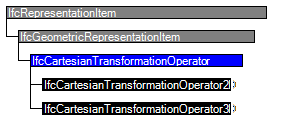Natural language names
 | Kartesische Transformation |
 | Cartesian Transformation Operator |
 | Opérateur de transformation cartésienne |
 | Kartesische Transformation |
 | Cartesian Transformation Operator |
 | Opérateur de transformation cartésienne |
An IfcCartesianTransformationOperator defines an abstract supertype of different kinds of geometric transformations.
NOTE Definition according to ISO/CD 10303-42:1992
A Cartesian transformation operator defines a geometric transformation composed of translation, rotation, mirroring and uniform scaling. The list of normalized vectors u defines the columns of an orthogonal matrix T. These vectors are computed, by the base axis function, from the direction attributes axis1, axis2 and, in Cartesian transformation operator 3d, axis3. If |T|= -1, the transformation includes mirroring. The local origin point A, the scale value S and the matrix T together define a transformation.
The transformation for a point with position vector P is defined byP -> A + STPThe transformation for a direction d is defined by
d -> TdThe transformation for a vector with orientation d and magnitude k is defined by
d -> Td, and
k -> SkFor those entities whose attributes include an axis2 placement, the transformation is applied, after the derivation, to the derived attributes p defining the placement coordinate directions. For a transformed surface, the direction of the surface normal at any point is obtained by transforming the normal, at the corresponding point, to the original surface. For geometric entities with attributes (such as the radius of a circle) which have the dimensionality of length, the values will be multiplied by S.
For curves on surface the p curve.reference to curve will be unaffected by any transformation. The Cartesian transformation operator shall only be applied to geometry defined in a consistent system of units with the same units on each axis. With all optional attributes omitted, the transformation defaults to the identity transformation. The Cartesian transformation operator shall only be instantiated as one of its subtypes.
NOTE Entity adapted from cartesian_transformation_operator defined in ISO10303-42.
HISTORY New entity in IFC2x.
| # | Attribute | Type | Cardinality | Description | C |
|---|---|---|---|---|---|
| 1 | Axis1 | IfcDirection | [0:1] | The direction used to determine U[1], the derived X axis direction. | X |
| 2 | Axis2 | IfcDirection | [0:1] | The direction used to determine U[2], the derived Y axis direction. | X |
| 3 | LocalOrigin | IfcCartesianPoint | [1:1] | The required translation, specified as a cartesian point. The actual translation included in the transformation is from the geometric origin to the local origin. | X |
| 4 | Scale | IfcReal | [0:1] | The scaling value specified for the transformation. | X |
| Scl :=NVL(Scale, 1.0) | IfcReal | [1:1] | The derived scale S of the transformation, equal to scale if that exists, or 1.0 otherwise. | X | |
| Dim :=LocalOrigin.Dim | IfcDimensionCount | [1:1] | The space dimensionality of this class, determined by the space dimensionality of the local origin. | X |
| Rule | Description |
|---|---|
| ScaleGreaterZero | The derived scaling Scl shall be greater than zero. |

| # | Attribute | Type | Cardinality | Description | C |
|---|---|---|---|---|---|
| IfcRepresentationItem | |||||
| LayerAssignment | IfcPresentationLayerAssignment @AssignedItems | S[0:1] | Assignment of the representation item to a single or multiple layer(s). The LayerAssignments can override a LayerAssignments of the IfcRepresentation it is used within the list of Items. | X | |
| StyledByItem | IfcStyledItem @Item | S[0:1] | Reference to the IfcStyledItem that provides presentation information to the representation, e.g. a curve style, including colour and thickness to a geometric curve. | X | |
| IfcGeometricRepresentationItem | |||||
| IfcCartesianTransformationOperator | |||||
| 1 | Axis1 | IfcDirection | [0:1] | The direction used to determine U[1], the derived X axis direction. | X |
| 2 | Axis2 | IfcDirection | [0:1] | The direction used to determine U[2], the derived Y axis direction. | X |
| 3 | LocalOrigin | IfcCartesianPoint | [1:1] | The required translation, specified as a cartesian point. The actual translation included in the transformation is from the geometric origin to the local origin. | X |
| 4 | Scale | IfcReal | [0:1] | The scaling value specified for the transformation. | X |
| Scl :=NVL(Scale, 1.0) | IfcReal | [1:1] | The derived scale S of the transformation, equal to scale if that exists, or 1.0 otherwise. | X | |
| Dim :=LocalOrigin.Dim | IfcDimensionCount | [1:1] | The space dimensionality of this class, determined by the space dimensionality of the local origin. | X | |
<xs:element name="IfcCartesianTransformationOperator" type="ifc:IfcCartesianTransformationOperator" abstract="true" substitutionGroup="ifc:IfcGeometricRepresentationItem" nillable="true"/>
<xs:complexType name="IfcCartesianTransformationOperator" abstract="true">
<xs:complexContent>
<xs:extension base="ifc:IfcGeometricRepresentationItem">
<xs:sequence>
<xs:element name="Axis1" type="ifc:IfcDirection" nillable="true" minOccurs="0"/>
<xs:element name="Axis2" type="ifc:IfcDirection" nillable="true" minOccurs="0"/>
<xs:element name="LocalOrigin" type="ifc:IfcCartesianPoint" nillable="true"/>
</xs:sequence>
<xs:attribute name="Scale" type="ifc:IfcReal" use="optional"/>
</xs:extension>
</xs:complexContent>
</xs:complexType>
ENTITY IfcCartesianTransformationOperator
ABSTRACT SUPERTYPE OF(ONEOF(IfcCartesianTransformationOperator2D, IfcCartesianTransformationOperator3D))
SUBTYPE OF (IfcGeometricRepresentationItem);
Axis1 : OPTIONAL IfcDirection;
Axis2 : OPTIONAL IfcDirection;
LocalOrigin : IfcCartesianPoint;
Scale : OPTIONAL IfcReal;
DERIVE
Scl : IfcReal := NVL(Scale, 1.0);
Dim : IfcDimensionCount := LocalOrigin.Dim;
WHERE
ScaleGreaterZero : Scl > 0.0;
END_ENTITY;